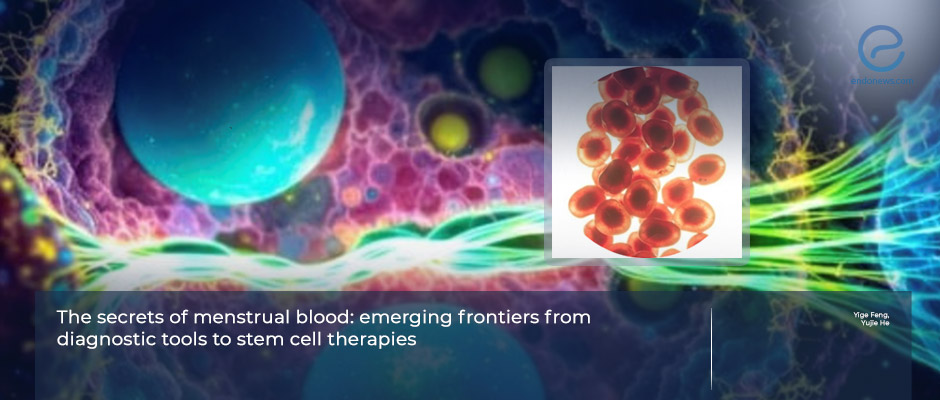Menstrual Blood–Derived Stem Cells and Diagnostic Advances
Oct 3, 2025
Noninvasive Menstrual Blood Testing Offers New Pathways for Early Diagnosis of Gynecological Diseases
Key Points
Highlights:
- Menstrual blood and stem cells (MenSCs) provide a noninvasive and abundant source of biological material with applications in both diagnostics and therapy:
- They show promise for tissue regeneration, immune modulation, and angiogenesis.
- In endometriosis, menstrual effluent analysis offers a window into early detection, pathophysiology, and potential targeted interventions with opportunities in regenerative approaches after surgical excision.
Importance:
- Endometriosis is traditionally diagnosed late and invasively. Menstrual blood–based diagnostics could revolutionize the field by enabling early, noninvasive detection of molecular and cellular biomarkers.
- Moreover, MenSCs represent a novel therapeutic avenue, with their anti-inflammatory, anti-fibrotic, and regenerative properties potentially helping repair endometrial and pelvic tissues damaged by endometriosis or its surgical treatment.
What's Done Here:
- This is a narrative review synthesizing recent advances in menstrual blood–based diagnostics and MenSC research.
- Covers biological properties, molecular markers, immunological roles, and regenerative potential of MenSCs.
- Discusses applications in gynecologic diseases, systemic disorders, and regenerative medicine.
Key Results and Impact on Endometriosis:
- Diagnostic potential: Menstrual effluent contains immune cells, extracellular vesicles, and molecular biomarkers (e.g., microRNAs, cytokines) that may distinguish women with endometriosis from healthy controls.
- Pathophysiology: Altered immune cell profiles in menstrual blood may reflect mechanisms underlying lesion establishment and persistence.
- Therapeutic potential: MenSCs demonstrate anti-inflammatory and pro-regenerative effects in preclinical models, offering hope for future therapies to reduce fibrosis and restore reproductive function.
- Post-surgical use: MenSCs could support healing of pelvic tissues following excision of endometriosis lesions.
Limitations of the Study:
- Current evidence is preclinical or early-stage clinical, requiring larger trials for validation.
- Variability in menstrual blood collection, processing, and standardization remains a barrier.
- Ethical and regulatory frameworks for MenSC therapies are still evolving.
- Diagnostic biomarkers from menstrual effluent require robust sensitivity and specificity testing before clinical adoption.
From the Editor-in-Chief – EndoNews
"This review underscores the transformative potential of menstrual blood as both a diagnostic tool and a therapeutic resource. For endometriosis, where delayed diagnosis and limited treatment options remain major barriers, the ability to identify molecular and cellular signatures in menstrual effluent could radically shorten the diagnostic timeline and reduce reliance on invasive laparoscopy.
Equally compelling is the promise of menstrual blood–derived stem cells. Their regenerative, anti-inflammatory, and anti-fibrotic properties suggest new therapeutic pathways for women suffering from recurrent disease or tissue damage after surgery. Although current evidence remains preliminary, the prospect of integrating menstrual blood–based diagnostics with MenSC-driven regenerative strategies offers a future in which both early detection and personalized therapy are possible.
The challenge now lies in standardizing collection and analysis, validating biomarkers in large, diverse populations, and rigorously testing MenSCs in clinical trials. If these hurdles are overcome, menstrual blood—once discarded as waste—could emerge as a powerful ally in transforming the landscape of endometriosis care."
Lay Summary
Menstrual blood is usually discarded as waste, but recent discoveries show it may hold extraordinary value for women’s health and medicine more broadly.
In a review published in Frontiers in Cell and Developmental Biology in 2025, Drs Feng and He from Shanxi Medical University, Taiyuan, China, highlight the growing body of research demonstrating that menstrual blood contains a rich source of biological information and unique stem cells that could change how we diagnose and treat many conditions.
For women with endometriosis, the potential impact is especially significant. Today, endometriosis is often diagnosed only after years of pain, infertility, and repeated medical visits, with confirmation requiring invasive surgery. Researchers are finding that menstrual blood contains immune cells, proteins, genetic markers, and microRNAs that differ between women with and without endometriosis. These differences may provide the basis for a noninvasive diagnostic test, offering earlier and more accurate detection without the need for surgery. If validated, such tests could dramatically reduce diagnostic delays and improve care for millions of women worldwide.
In addition to diagnostics, menstrual blood contains menstrual blood–derived stem cells (MenSCs), which are proving to be highly versatile. These cells can reduce inflammation, promote healing, and generate new blood vessels. Experimental studies suggest MenSCs might be used in the future to repair pelvic tissues damaged by endometriosis or its surgical treatment, to prevent fibrosis, and perhaps even to improve fertility outcomes. Beyond gynecology, these stem cells are also being studied in regenerative medicine for conditions as varied as liver disease, neurological injury, heart disease, and even COVID-19.
Despite this promise, much work remains. Larger clinical studies are needed to confirm the reliability of menstrual blood–based biomarkers for endometriosis, and regulatory frameworks must be established before MenSC therapies become widely available. Variability in how menstrual blood is collected and processed is also a challenge for standardization.
Still, this review points to a hopeful future: what was once dismissed as a waste product may instead become a powerful ally in diagnosing endometriosis earlier, reducing suffering, and opening new frontiers in regenerative treatment.

